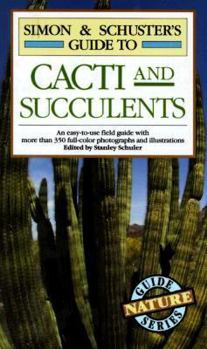Simon & Schuster's Guide to Cacti and Succulents: An Easy-To-Use Field Guide with More Than 350 Full-Color Photographs and Illustrations
(Part of the Simon & Schuster's Nature Guide Series Series)
Select Format
Select Condition 
Book Overview
Provides information on the names, characteristics, cultivation, and geographic distribution of more than 300 species of cacti and succulent plants.
Format:Paperback
Language:English
ISBN:0671602314
ISBN13:9780671602314
Release Date:December 1985
Publisher:Touchstone Books
Length:384 Pages
Weight:1.29 lbs.
Dimensions:0.9" x 4.7" x 7.5"
Customer Reviews
7 ratings
Disappointed
Published by Gina , 8 days ago
The title states cacti AND succulents... theres no succelents in the book.. just cactii
Not a word on succulents
Published by Sandy , 11 months ago
Not a single word about succulents.. only cacti... Very misleading. And USELESS in my search... Sad
Best Cactus Photo Guide
Published by Thriftbooks.com User , 17 years ago
This book has the best photos I have ever seen. The descriptions are wonderful but if you collect cactus you know that pictures are the defining way to know exactly what you have. This book is #1 for me.
SIMON & SHUSTER'S GUIDE TO CACTI & SUCCULENTS
Published by Thriftbooks.com User , 19 years ago
THIS IS A MUST HAVE FOR THE SERIOUS CACTUS COLLECTOR. SMALL, FAT, SUPER CLEAR AND CONCISE MODULARIZED ENTRIES WITH PICTURES, AND SPECIFICATIONS OF EACH CACTUS TYPE. THE ONLY THING I HAVE SEEN BETTER IS THE HUGE ANDERSON BOOK TITLED "THE CACTUS FAMILY", A BEHEMOUTH DEFINITIVE VOLUME. THIS LITTLE BOOK IS THE NEXT BEST THING I HAVE SEEN ANYWHERE.
Many entries.
Published by Thriftbooks.com User , 20 years ago
This guide to Cacti and Succulents is one of the greatest field guides that I have ever bought in my giant private collection of field and naturalist guides. As said above, this has numerous species and subspecies entries. I have never seen another cactus field guide with so many listings, mainly of cacti. There are a few succulents, but the cacti are the MAIN part of this book. If you want a guide to local succulents, purchase "Succulents", and "Succulents 2: The Illustrated Dictionary". But, if you are seeking out cacti, whether to plant them in a backyard, or simply find them in the field, this a priority to purchase. The photographs themselves are beautiful and DO show enough of the plant for field identification. A few of the more familiar species are listed along with common names, but this is not needed for the advanced naturalists it is geared toward. Also recommended: "Cacti: The Illustrated Dictionary."
Another very good cactus reference
Published by Thriftbooks.com User , 21 years ago
I found this book to be both useful and informative, but not as one's only reference. It's a little too "biological".The pictures are good - they generally show enough of the plant, including the flowers to help with identification. It has been noted that it is not always possible with these pictures to completely identify some species. This is true. Many species of cactus look nearly identical and require an experienced botanist to tell them apart, even given the actual physical plants.This book is not quite as complete as some of the larger tomes (e.g.: "Illustrated Encylopedia of Cacti" by Clive Innes, et al), in terms of number of species, but the description for each specimen is often more complete. Many entries include comments that would not be necessary to merely identify the plant. Some comments are even (very) slightly chatty and opinionated.At the front of the book is the best description of the scientific names of cactus that I have ever seen. It includes a detailed history of why cactus plants are named as they are, and shows how to understand them. Also explained is why there is disagreement between various books regarding the names of some cacti. Believe it or not, these plants are named logically.Gripe: the text is quite long on botanical jargon while at the same time, the glossary is stupidly terse. The book is obviously written for the non-biologist, and yet the book is peppered with botanical terms (like "ramified") that are nowhere-between-the-covers defined. Yet the book has a pronunciation guide to the latin terms, which no botanist would need... very strange.There are no hybrid (e.g.: cultivated) species represented at all. Other books do include the hybrids.In spite of the title, there are no non-cactus succulents listed. The text makes this clear within a few paragraphs of the beginning, but if you bought the book without looking inside at all, you'd be mislead by the title.Note: every author has a section about "how to water cactus", with his or her own strong opinions. No one book has the full story. They all agree that there is no rote method that does not require taking your own plants' situations into account. This book is particularly, perhaps overly, strident regarding best practices, and some other (almost _any_ other) cactus reference should also be consulted to gain some perspective.I had previously rated this book as "4 stars" but I have changed my mind. It has turned out to be the cactus reference that I most often use. If you want one book with both cactus and other scculents thenTerry Hewitt's "Complete Book of Cacti and Succulents" is probably a better choice but this book makes an excellent reference.
Wonderful book!
Published by Thriftbooks.com User , 23 years ago
This book contains a lot of information on cacti, a break away from books containing both cacti and succulents. The photos are breath-taking. One of their really good works!







